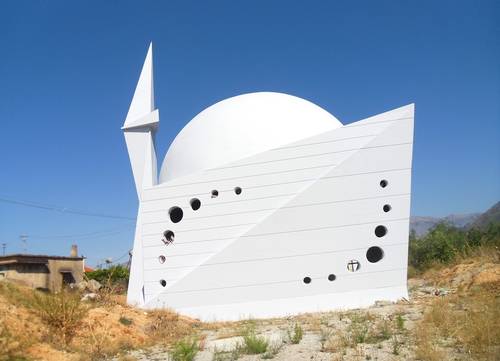Albania, largely a Muslim country during the long Ottoman occupation, albeit with Christian and Jewish minorities, became an officially atheist state in 1967. The practice of any form of any religion was banned, cultic buildings were either destroyed or simply abandoned and allowed to crumble. In the early 1990s, during the turmoil that shook the Balkans and, further east, the Soviet Union, Albania came out of its seclusion, rekindling contacts with the West. Many people left the country in search of a better life abroad. The ban on religion was lifted but with no dramatic results. Twenty odd years of enforced atheism seemed to have smothered any feelings in that direction. Albanian society today can be described as largely secular. Sparsely dotted here and there, one can see old buildings with new crosses, replacements of those taken down; old mosques that have been restored; and a few new structures. The dearth of synagogues may be due to the flight of the Jewish community to Israel. On the whole, religious practice is very muted. Church bells, with their distinctive dry and sharp sound are rarely heard, muezzins seem to call the faithful only twice a day and even then their call is low key, almost apologetic and only lasts a couple of sentences. Not all villages have a mosque or a church: they are altogether pretty thin on the ground.

In the south, in the hinterland on a secondary road to Delvina from Saranda, in a small village that has no name since the practice of road signing is still in its infancy (adding an extra challenge to driving), is the mosque in the picture. It sits by the road and cannot be missed. It is not yet finished and the interior is still full of bags of cement while the surroundings need landscaping and a fountain for ritual ablutions. The style is interesting, though: it is new for Albania and for mosques in general. Other buildings of this sort tend to be rectangular and rather squat, with a dome covered in shiny material and a pencil minaret. They conform to a type that one can see in Turkey, for instance. Indeed, some of the new Albanian mosques are the bequests of the Turkish people. This one, with its stark outside, daring lines and imaginative architecture, is truly a departure from the standard model. It is small but better proportioned. The blue sky of the August sun (when the picture was taken) makes a wonderful background. The crooked minaret, asymmetric dome and new style windows are arresting. It will be interesting to see how the light plays inside. Albania has not been particularly noted for its architecture. Now, at long last, it is putting its name on the map.
by Paola Pugsley, author of Blue Guide Crete and three Blue Guide e-chapters on Turkey. A fourth, covering Central Anatolia, is in production. For the special reprint edition of Blue Guide Albania & Kosovo, see here.






